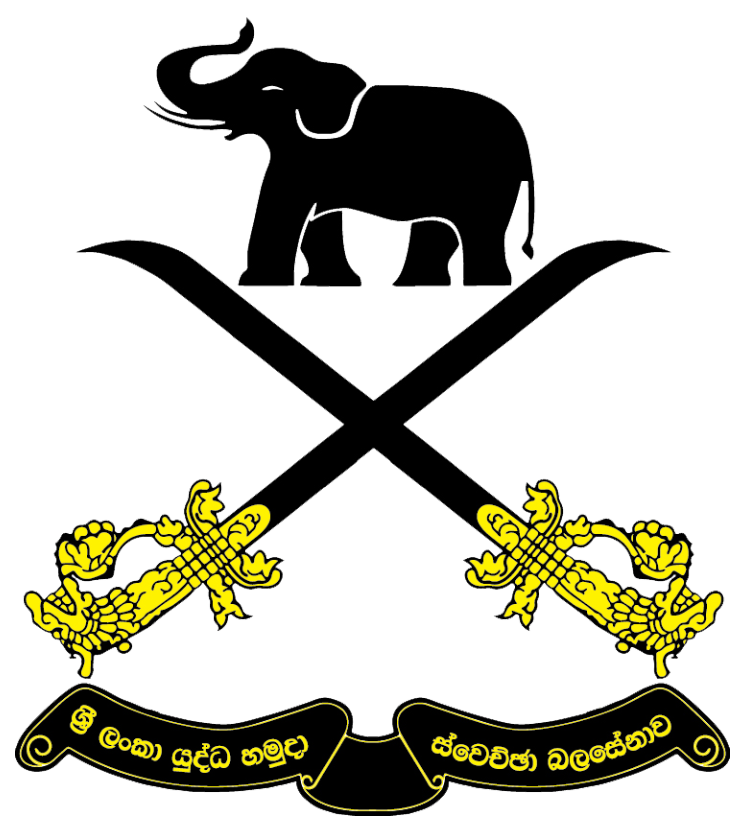Beginnings (1881 - 1898)
The origin of the volunteer movement was in 1861 when the governor wrote to the war office for approval of such a movement. The volunteer movement grew out of a civilian rifle club and was broad-based for infantry soldiering by a proclamation issued by the Lieutenant Governor (Sir John Douglas KCMG) in the government gazette of 1st April 1881 authorizing the formation of “the Ceylon Light Infantry Volunteers (CLIV)”. Thirteen days later, Lieutenant Colonel John Scott Armitage was appointed as the Commanding Officer. His Royal Highness Albert Edward, Prince of Wales (The Late King Edward VII) accepted the Honorary Colonelcy of the Regiment and permitted the use of his motto “IchDien” and his personal insignia to the Regiment.
In 1890, the Governor of Ceylon, Sir Arthur Hamilton Gordon was appointed Honorary Lieutenant Colonel of the Regiment. It can safely be said that the beginnings of the CLIV formed the underpinnings not only of the volunteer military movement in Sri Lanka but also of the Sri Lanka Army.
The ranks of the Corps of Volunteers were thereafter speedily filled. Sir James Longdon, the Governor held the first inspection of the Corps on 26th November, 1881 and the first official inspection by Major General Sir George Mcleod took place on 23rd September 1882. The volunteer movement was then encouraged by the raising of several companies under the aegis of the CLIV in the main towns and districts of Sri Lanka and there was also the formation of companies on a professional basis.
- Volunteer Force Movement was originated in 1861.
- The movement grew out of a civilian riffle club and was broad based for infantry soldiering.
- The Ceylon Light Infantry Volunteers (CLIV) was raised by the Government Gazette of 1st April 1881.
- Lieutenant Colonel John Scott Armitage was appointed as the first Commanding Officer of CLIV.
- His Royal Highness Albert Edward, Prince of Wales (The Late King Edward VII) accepted the Honorary Colonelcy of the Regiment and permitted the use of his motto “IchDien” and his personal insignia to the CLIV.
- Expanded since 1883 with the formation of companies on professional basis.
- A Company of Mounted Riffles was enrolled on 12 July 1892, which was later formed as Ceylon Mounted Riffles.
- A Corps of Artillery Volunteers was raised in 1888.
- The first camp was held in September 1890 at Uragasmanhandiya that continued until 1902 and shifted to Diyatalawa in 1903.
The next year saw the formation of new companies and Detachments of Infantry in Batticaloa, NegomboMatara andHambantota. Professional groups were instrumental in raising the Bearer Company, Break-Water Company, Railway Company, Legal Company (the Devil’s Own) and the Public Works Company. Meanwhile, a Company of Mounted Infantry was enrolled on 12th July 1892 in Kandy.
This emerged later as the Ceylon Mounted Rifles (CMR). A Corps of Artillery Volunteers (CAV) was raised in 1888 with additional companies of Artillery Volunteers in Trincomalie and Galle.
A valuable Juncture was the formation of a Cadet Battalion (CB-CLI) to encourage the military movement in schools which developed later into the Ceylon Cadet Battalion (CCB) and finally as the National Cadet Corps (NCC).
In the earliest years, the Force was armed with the Long Snider Rifle. This was replaced in 1890 by the Martini - Henry and there was a further change in the same year when the entire Force was re-armed with Martini-Enfield Rifles.
The earliest camp was held in September 1890 at Uragasmanhandiya and that was witnessed a yearly gathering until 1902. In 1903, the camp was moved to Diyatalawa.
| Ceylon Artillery Volunteers | - | 129 |
| Ceylon Mounted Infantry | - | 110 |
| Bearers | - | 50 |
| Cyclists | - | 5 |
| Ceylon Light Infantry | - | 868 |
| Total | - | 1162 |
| Total Strength of CLIV in 1900 | ||

Diyatalawa Camp in 1903
THE SOUTH AFRICAN WAR (1899- 1902)
The Mounted Infantry Company of the CLIV was raised in 1892 by Colonel Gordon - Reeves of Hoolankande Estate, Madolkele. This later became a separate unit - CMR - of the Ceylon Defence Force (CDF). As the CMR, contingent left for the Boer War in 1899 under the commander of Major A.H. Rutherford. The Mounted Infantry distinguished themselves in engagements against the Boers at Dreifontein, Diamond Hill and Wittebergen.
A second contingent consisting of members of the Ceylon Planters’ Rifle Corps (CPRC) Commanded by Capt J.Stewart of Sutton State Agarapatana left in April 1902 for South Africa. This Corps was formed on 5th May 1902. At the end of the war a message from Lord Kitchener at Simla was received, commanding the work of the Ceylon Contingents. Another connection with this period was the presence of the Boer prisoners who were in Diyatalawa.
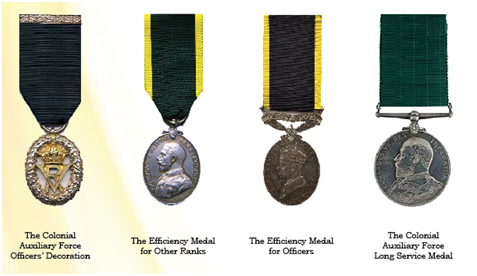
Decorations Medals
CONSOLIDATION (1910-1939)
In 1910 the CDF was raised under Ordinance No 8 of 1910 to provide good order and discipline of the local force in Ceylon and which comprised all volunteer units. The Commanding Officers of all volunteer units were responsible to Commandant of the Ceylon Defence Force.
During the period of British rule and early Dominion Status, the volunteers were awarded decorations and medals by the British Sovereign. Officers were entitled to the letters VD (Volunteer Officers Decoration) and ED (Efficiency Decoration) after their names respectively.
WORLD WAR I
During the period of the First World War (1914-1918), the Volunteer Force was called out on active service. Records indicate that these troops were deployed in guarding Vulnerable Points (VPs) in the city of Colombo. As the offer of overseas service by a contingent was refused by the Goa Operation Command (GOC) troops in Sri Lanka, several Officers and men among the volunteer militia left for England and joined the British units of the line.
In 1914, an overseas contingent composed of 8 Officers and 221 Other Ranks of the CPRC embarked for the first Great War and saw service in the Suez Canal military area and Mesopotamia. Others became in several line regiments of the British Indian Army. In 1928, H.M. The King approved of an alliance between the CPRC and the Rifle Brigade.
Undoubtedly, the high point of this period was the visit in March 1922 of HRH Edward Prince of Wales (later HM King Edward the VII). On this occasion, King’s and Regimental Colours were presented (22nd March 1922) to the CLIV during the period of command of Lt Col T.G. Jayawardene. VD CLI.
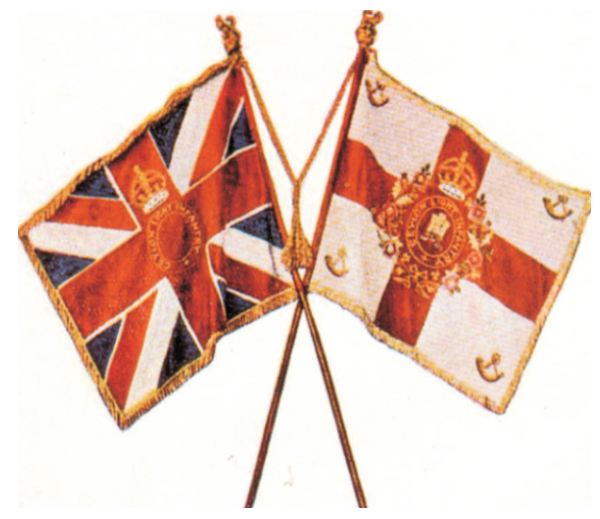
Queen's Colours
Presented on 22 March 1922
In 1917, the CLIV relieved the 80th Carnatic Regiment of duties in Sri Lanka in the form of a mobilized detachment billeted in Echelon Barracks. The Bearer Company formed a unit which was renamed as the Ceylon Medical Corps (1890) with affiliation to the Royal Army Medical Corps and much later as the 2 (V) Ceylon Army Medical Corps (1949) and finally Sri Lanka Army Medical Corps (Volunteer) (1972).
- Volunteer Force was called for active service and deployed for the protection of VPs Colombo.
- 08 X 221 Embarked on an overseas contingent in 1914 and was deployed in Suez Canal military area and Mesopotamia.
- On 22 March 1922 the CLI was awarded King’s and Regimental Colours.
- Presence of Boer prisoners in Diyatalawa
In the same manner, elements of the CLIV which was concerned with supply and transport formed Ceylon Supply and Transport Corps (1918) and was affiliated to the Royal Army Service Corps (1930) finally emerging before WW II as Ceylon Army Service Corps (1933) and the 2 (V) Ceylon Army Service Corps (1949).
Ceylon Artillery Volunteers were re-structured as Ceylon Garrison Artillery (CGA) (1910) emerging in (1949) as the 2 (V) Anti-Aircraft/Coast Artillery Regiment. The Engineering Company of the CLIV formed in 1881 was renamed as the Ceylon Engineers Corps (1911) which later in (1949) resulted in a change of nomenclature to the 2(V) Ceylon Army Engineers Corps.
On mechanization of all cavalry units in the British Army prior to WW II, CMR (allied to the 17th and 21st Lancers) was disbanded and was amalgamated on 24th September 1938 with the CPRC.
Instructional staff was drawn from several notable regiments in the UK (The Guards and the Rifle Brigade) and were resident in Colombo, Kandy and Diyatalawa. The Adjutants of the CMR and CPRC were hand-picked veterans of WW I notably Capt Sir Berkeley Pigott MC and Capt Sir Willian Honeywood MC both from the 17th and 21st Lancers. Instructional week-end classes and camps were held in several centres and mini-rifle ranges located at such centres were very popular.
WORLD WAR II
On the commencement of hostilities against Germany, the CDF was mobilized for active duty. Troops in garrison in Colombo and Trincomalie were assisted by elements of a British Indian Division and the reorganized Ceylon Garrison Artillery as Coast – Artillery and Anti-Aircraft Units.
With the entry of Japan into the War, a new dimension of expansion of the CDF was experienced. CLIV was expanded to contain five battalions with a Regimental Commander. The Engineer Unit was divided into functional field engineering and plant operational units with a training depot/wing. Signals, Medical and logistics units were expanded to support units in forward and reserve areas.
The removal of Headquarters South East Asia Command (SEAC) from the Indian sub-continent and the location of its forward headquarters by Admiral Lord Louis Mountbatten in Kandy is noteworthy to mention in the military history of Ceylon. The CDF benefitted greatly by being brigaded and trained with several British regiments during their training halted in Ceylon before embarking for the Burma Front. Officers also had the opportunity of training in India and in forward areas on the Burma Front. VGA and the CLIV saw overseas service in the defence of the Seychelles and Cocos Islands. Members of the CPRC who had not offered themselves for active duty in Britain were posted to British Indian Regiments on the sub-continent and others remaining in Sri Lanka were made use of Intelligence Sections of SEAC.
TOWARDS INDEPENDENCE AND A REPUBLICAN CONSTITUTION (1946 - 1972)
In the aftermath of demobilization after WW II, a problem of finding employment for service personnel arose.
- Participation in the Victory Parade in year 1946 in Britain.
- The enactment of the Army Act in 1949.
- Volunteer elements grouped together as Ceylon Volunteer Force.
- Establishment of the Rajarata Riffles and Ruhunu Regiment.
- Disbandment of the Rajarata Riffles and Ruhunu Regiment and rising of 2 (V) Bn SLSR.
- Appointing of Ceylonese for the positions officially held by British Officers
Solutions were found out in settling some of them in the colonization scheme in the North Central Province and supplying the needs of recruits from the Royal Pioneer Corps (RPC) for service in Malaya.A contingent of the CDF represented the country in the Victory Parade in 1946. Then saw the process of Colonization in the CDF putting in place resulting in the appointing of Ceylonese to positions formerly held by British Officers. With the declaration of Independence in 1948, elements of the CDF took part in the first Independence Day Parade at which HRH Henry Duke of Gloucester, Honorary Colonel of the CLIV was present.
In 1949, the Army Act was passed on the 10th of October which resulted in several changes. Maj Gen A.M. Muthukumaru stated that:
"With the enactment of the Army Act, the affairs of the CDF underwent a metamorphosis. CDF Force Ordinance was repealed and the HQ of the CDF disbanded, but units of the CDF continued as units of the Volunteer Force which was the volunteer counterpart of the Regular Force. The name allotted to the Volunteer element was Ceylon Volunteer Force (CVF), so that it seemed to have turned full cycle and resumed the name with which it came into existence at the end of the 19th Century namely, CLIV and changed not long after to CVF before it became the CDF”.
Consequent to the exercise in re-naming, the CVF later consisted of the following Units:
2 (V) Anti-Aircraft/Coast Artillery Regt
2 (V) Ceylon Army Signal Corps
2 (V) Ceylon Army Engineer Corps
2 (V) Ceylon Light Infantry
2 (V) Ceylon Army Service Corps
2 (V) Ceylon Army Medical Corps
Units Formed Under CVF
Highlights of the Volunteer Force history in the early years after Independence showed that the force was mobilized for duty during the “Hartal” of 1953. In 1954 on the occasion of the visit of HM Queen Elizabeth II to Sri Lanka, Queen’s and Regimental Colours were awarded to the 2 (Volunteer) Ceylon Light Infantry 2 (V) CLI at a spectacular parade in Galle Face Green. In 1955, the Headquarters of the CVF was formed on February the 27th under the command of H.W.G. Wijekoon OBE ED.
During the period 1954 – 1955, ‘B’ Rifle Company located in Matara and ‘C’ Rifle Company located in Kandy broke away from the 2 (V) CLI to be the nuclei of newly raised volunteer battalions, ‘B’ Company forming the nucleus of the Ruhunu Regiment (Volunteers) and ‘C’ Company like-wise forming the Rajarata Rifle (Volunteers).
With changes in Political thinking, recruiting on a regional basis was curtailed and emphasis was given to recruitment on a national basis by 1955. This resulted in the disbandment of the Ruhunu Regiment and Rajarata Rifles and the raising of the 2nd (Volunteer) Battalion of the Sinha Regiment on the 10th October 1956 who’s first Commanding Officer was Lt Col SD Rattwate ED. Later, the 2 (Volunteer) Battalion of the Gemunu Watch was raised on 23rd November 1959 whose first Commanding Officer was Lt Col DS Amarasuriya. In 1962, it was seen expedient by the authorities to disband the Volunteer Artillery Regiment and the Volunteer Signal Squadron. Personnel from these disbanded units were re-grouped as the 1st Battalion and 2nd Battalion the Ceylon National Guard and later as the 2nd Sri Lanka Armoured Corps (Volunteers) and 5th Sri Lanka Artillery Corps (Volunteers) in 1979 and 1980 respectively.
In 1959, a Volunteer unit from Pioneer Corps was raised as the Ceylon Army Pioneer Corps (CAPC) under the command of Lt Col M.C.F. Abeykoon. Other units raised during the period (1946-1972) were as follows:
| Unit | Loc of Headquarters | Date Raised |
| 4 SLE (V) | Colombo | 1-Sep-64 |
| 3 (V) GW | Matara | 1-Sep-65 |
| 3 (V) SLSR | NuwaraEliya | 1-Oct-69 |
| 2 SLAC (V) | Pallekelle | 1-Jan-79 |
| 5 SLA (V) | Colombo | 22-Jan-80 |
Units Raised During the Period from 1946 to 1972
Serious disturbances resulting from youth unrest during 1971 saw the mobilization of the Volunteer Force and internal security role and it is a matter of record that the first casualty (Killed in Action) of the new Ceylon Army was S/45 S/Sgt Jothipala HR of the 2 (V) SR at Thulhiriya on 05th April 1971. Volunteer Battalions were also tasked in Task Force Anti-Illicit Immigration (TFAII) from 1964 onwards. During the insurrection in 1971 a new regiment was raised to meet the additional requirement of man-power. This was the National Service Regiment. This Regiment was subsequently disbanded and most Officers and soldiers were absorbed into other Volunteer Units.
IN SERVICE OF THE REPUBLIC (1972 - 1998)
With the proclamation of the Republic of Sri Lanka on 22nd May 1972, the nomenclature of the CVF was (and its several units) changed accordingly to the Sri Lanka Army Volunteer Force (SLAVF). With the upsurge of violence Island wide on 23rd July 1983, consequent to the killing of 13 Sri Lanka Army personnel in the North and the intransigent attitude of the Liberation Tamil Tiger Ellam (LTTE) towards a negotiated political settlement in 1983, the Volunteer Force was called out for active duties. a Deployment of Volunteer Units was mainly seen in the North and Eastern Districts but there were several occasions when Volunteer Units also served in the South to counter anti – government activities brought on by militant Janatha Vimukthi Peramuna (JVP) groups. A rapid expansion of the SLAVF was seen in this period.
The expansion could not have been effected without the establishment of the Volunteer Force Training School (VFTS). This establishment was tasked with the basic training of Officers and Recruits for the SLAVF. Headquarters for the training school was established at Diyatalawa under the command of Lieutenant Colonel W R B Rathnayake SLLI. The number of recruits trained during the period from 5 December 1988 to 4 February 1998 was 12,850
The contribution towards the enhancement of military skills in jungle training and exercises in the field, by Brigadier B.K.V.J.E. Rodrigo VSV ndcpsc MA during the period of Office as Commandant (1977 – 1981) can not be easily forgotten.
With the rapid expansion of the SLAVF and the burgeoning administration that was required for the maintenance of good order, Headquarters SLAVF was moved from the premises of the Army Headquarters to a new location at Pelawatte on 14th September 1991. This was effected during the tenure of Office of Major General Y. Balaratnarajahndc as Commandant with Brigadier C N Panabokke KSV as Deputy Commandant. In 1978 and in 1980 respectively, HE the President honoured the 2 (V) SLLI and the two Volunteer Battalions of the Gemunu Watch, 2 (V) GW and 3 (V) GW respectively with the presentation of Presidential and Regimental Colours.
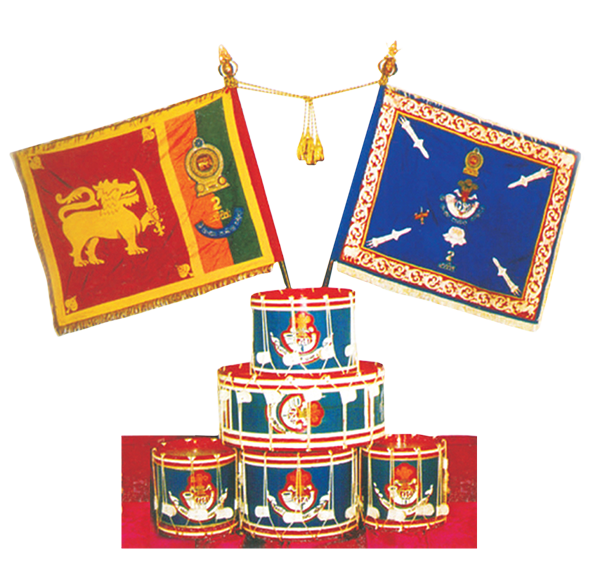
President Colours Awarded on 10 Oct 1978
In the year 1991, with the raising of sixteen Sri Lanka National Guard Battalions (SLNG), a Regimental Centre with a Brigadier as the Regimental Commander was appointed for this new establishment. Centenary Medal was awarded to the eligible personnel.
Recognition of the importance of the SLAVF as valued constituent of the Sri Lanka Army came in the form of the approval of new military awards and promotions. On 10 December 1990, HE the President as the Commander in Chief of the Armed Force in Sri Lanka approved the award of the “Kariyakshama Seva Vibhushanaya” (KSV) to Officers and the “Kariyakshama Seva Padakkama” (KSP) to Other Ranks of the SLAVF. On 1st April 1981, the Centenary Medal was awarded to the eligible personnel.
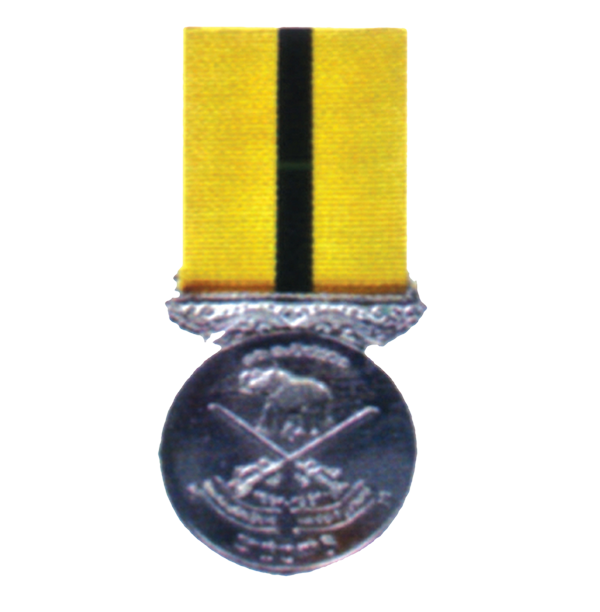
Centenary Medal

KSV Medal
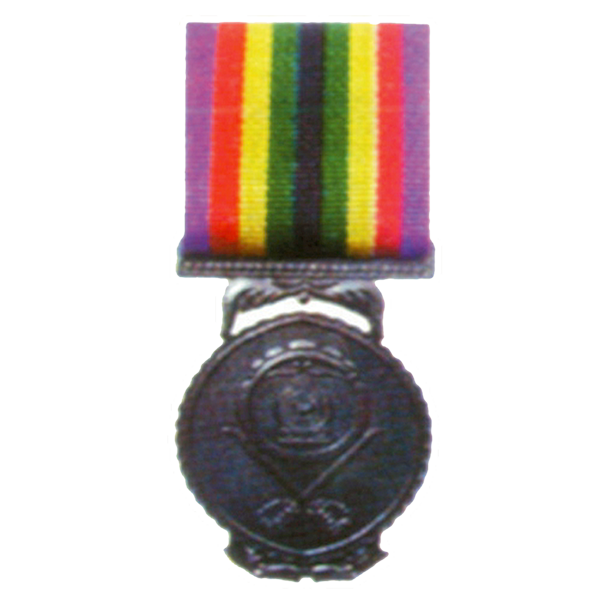
KSp Medal
Decorations Medals
A water-shed decision announced in government gazette no: 562/11 of the 6 June 1989 permitted the payments of Pensions to the personnel of the SLAVF. This was due mainly to the efforts of Brigadier N.G.A.L.D.S. de S. Wijesekara and Brigadier C.N. Panabokke KSV.
In the year 1995 with the rapid expansion of the SLAVF, the organization of its headquarters was re-structured and the rank of the Deputy Commandant was elevated from Brigadier to the rank of Major General.
On the eve of retirement in 1996 from the SLAVF, the Deputy Commandant, Brigadier N P D Pelpola KSV was promoted to the rank of Major General subsequent to which Brigadier S.V. Panabokke KSV was promoted to the rank of Major General wef 12 June 1996 holding the office of the Deputy Commandant as the first serving (Volunteer) Major General in the history of SLAVF.
Members of the SLAVF have immensely contributed to the war against terrorism in the past 30 years. One of the pioneers of the contributors is Captain Saliya Aladeniya who is the first recipient of "Parama Weera Vibhushanaya" (PWV). In safeguarding the country, a large number of soldiers sacrificed their lives while thousands of soldiers sustained injuries.
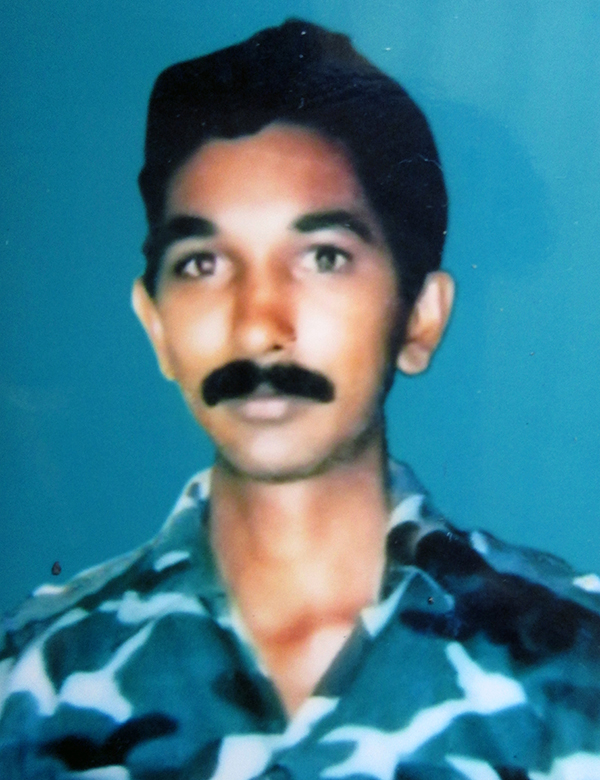
Captain Saliya Aladeniya PWV SLSR
PAST DISTINGUISHED MEMBERS OF SLAVF
The success of an organization is measured in terms of its contribution to the society. The volunteer military organization in Sri Lanka reached veritable heights with the contributions made by many of its members in the leadership of the nation. It is worthy of mentioning that Sri Lanka's first Prime Minister, Hon DS Senanayake PC was in the Volunteer Artillery as an active member for many years.
General Sir John Kotelawala CH PC KBE LLD from the CLIV will be remembered not only as a Prime Minister of Sri Lanka but also for his munificence in bequeathing the broad acres of his Kandawela Estate and spacious domicile to the establishment of General Sir John Kotalawala Defence Academy (KDA) for the training of young Officer Cadets. Another notable was Major E.A. Nugawela ED of the CLIV who was the Minister for Education in the first cabinet of independent Sri Lanka. The first Commanding Officer of 3 (V) GW, Colonel C.A. Dharmapala OBE ED was a Member of Parliament, later the Secretary of the Ministry of Defence and Security Advisor to HE the President (1977-1979).
Major Montague Jayawickrama, the Minister of Parliamentary Affairs and Plantations and Capt C.P.J Senevirathne, the Labour Minister during the period of (1977-1983) were active members of the 2 (V) CLI and Ceylon Cadet Corps respectively. General Ranjan Wijerathne who resuscitated the Planters' Rifle Corps was the Deputy Minister of Defence during the period 1989-1992.
Deshamannaya Nissanka Wijerathna was a commissioned officer of the Volunteer Artillery. He was a reputed civil servant to the nation and served as the Diyawadana Nilame of the Sri Dalada Maligawa - Kandy. General Anuruddha Rattwatte was a commissioned officer of the 2 (V) SLSR and subsequently went on to be appointed as the Minister of Defence.
MrKaru Jayasuriya served the nation as a commissioned officer during the period from 1965 to 1972. Since then, he is identified as an active political figure in the country holding many key cabinet Ministerial Portfolios and serving as the Speaker of the House in the last government.
Mr Hendri Pedris has served the nation as a Captain rending his valuable service in protecting Vital Points in Colombo during the WW 1. He is spoken of as a brilliant marksman and horse rider. MrUpali Amarasiri was commissioned on 4 September 1985 and subsequently went on to represent the Parliament from 1987 to 2000.
VOLUNTEER BATTALION RAISED SINCE ITS INCEPTION IN YEAR 1881 TO YEAR 1981
| Name of Unit | Date of Raising | Remarks |
| Ceylon Light Infantry Volunteers | 1 April 1881 | Now 2 (V) Bn SLLI |
| Corps of Artillery Volunteers | 1988 | Was restructured as Ceylon Garrison Artillery in 1910 |
| Emerged as the 2 (V) Anti-Aircraft /Coastal Artillery Regiment in 1949 and disbanded in 1962 | ||
| Ceylon Medical Corps | 1890 | Formed by converting the Bearer Company of CLIV and renamed as 2 (V) SLAMC since 1972 |
| Ceylon Mounted Riffles | 1892 | Disbanded on 24 September 1938 and amalgamated to CPRC |
| Ceylon Planters Riffle Corps | 1902 | Renamed as SLRC |
| Ceylon Engineers Corps | 1911 | Later renamed as 2 (V) Ceylon Army Engineers |
| Disbanded in 1962 | ||
| Ceylon Signal Corps | 1911 | Renamed as 2 (V) SLSC since 1972 |
| Corps of Ceylon Supply and Transport | 1918 | Formed by grouping the S&T elements of the CLIV and renamed as 2 (V) Regt SLASC since 1972 |
| Ceylon Pioneer Corps | 1939 | Later formed the SLAPC |
| Ruhunu Regiment | 1954 -1955 | Formed by re-structuring the B Company of 2 (V) CLI located at Matara |
| Disbanded in year 1956 | ||
| Rajarata Riffles | 1954 -1955 | Formed by re-structuring the C Company of 2 (V) CLI located at Kandy and disbanded in year 1956 |
| 2 (V) SR | 10-Oct-56 | Raised with the disbandment of Rajarata Riffles and renamed as 2 (V) SLSR since 1972 |
| 2 (V) GW | 23-Nov-59 | Raised with the disbandment of Ruhunu Regiment |
| 1 Bn Ceylon National Guard | 1960s | Raised with the disbandment of 2 (V) Anti-Aircraft /Coastal Artillery Regiment and went on to create 2 (V) SLAC |
| 2 Bn Ceylon National Guard | 1960s | Raised with the disbandment of 2 (V) Anti-Aircraft /Coastal Artillery Regiment and went on to create 5 (V) SLA |
| 4 (V) Regt Ceylon Engineers | 1-Sep-64 | Presently on active duties |
| 3 (V) GW | 1-Sep-65 | Presently on active duties |
| 3 (V) SR | 1-Oct-69 | Presently on active duties |
| 2 (V) Regt SLAC | 1-Jan-79 | Disbanded in 1987 and restructured as 5 (V) SLLI |
| 5 (V) Regt SLA | 22-Jan-80 | Presently on active duties |
VOLUNTEER BATTALION ON ACTIVE SERVICE
| Regiment | Regiment/Unit | Date of Raising | Remarks |
| SLAC | 2 (V) SLAC | 1-Jan-79 | Disbanded on 15 August 1987 and formed 5 (V) SLLI |
| 7 (V) Regt SLAC | 22-May-98 | Converted from 7 SLNG | |
| SLA | 5 (V) Regt SLA | 22-Jan-80 | |
| 12 (V) Regt SLA | 9-Sep-90 | Converted from 8 SLNG | |
| SLE | 4 (V) Regt SLE | 1-Sep-64 | |
| 15 (V) Regt SLE | 3-Mar-09 | Converted from 33 SLNG | |
| SLSC | 2 (V) Regt SLSC | 28-Apr-11 | |
| SLLI | 2 (V) Bn SLLI | 01 April 1881 | |
| 5 (V) Bn SLLI | 15-Aug-87 | ||
| 9 (V) Bn SLLI | 1-Nov-93 | ||
| 14 (V) Bn SLLI | 30-Dec-96 | ||
| 16 (V) Bn SLLI | 1-Dec-07 | ||
| 17 (V) Bn SLLI | 30-Mar-08 | ||
| 18 (V) Bn SLLI | 1-Jan-09 | Disbanded on 29 July 2018 | |
| 21 (V) Bn SLLI | 16-Mar-09 | Disbanded on 29 July 2018 | |
| 22 (V) Bn SLLI | 14 Junuary 2009 | Disbanded on 30 March 2012 | |
| SLSR | 2 (V) Bn SLSR | 1-Oct-56 | |
| 3 (V) Bn SLSR | 15-Aug-69 | ||
| 5 (V) Bn SLSR | 1-Feb-87 | ||
| 11 (V) Bn SLSR | 16-Apr-94 | ||
| 15 (V) Bn SLSR | 23-Dec-96 | ||
| 17 (V) Bn SLSR | 1-Dec-07 | ||
| 18 (V) Bn SLSR | 30-Mar-08 | Disbanded on 03 August 2018 | |
| 19 (V) Bn SLSR | 31-Aug-08 | Disbanded on 03 September 2018 | |
| 22 (V) Bn SLSR | 1-Jul-09 | Disbanded on 10 March 2012 | |
| GW | 2 (V) GW | 23-Nov-59 | |
| 3 (V) GW | 1-Sep-65 | ||
| 10 (V) GW | 1-Jan-94 | ||
| 14 (V) GW | 31-Dec-96 | ||
| 15 (V) GW | 1-Dec-07 | ||
| 16 (V) GW | 9-May-07 | ||
| 20 (V) GW | 7-Mar-09 | Disbanded on 21 November 2018 | |
| 21 (V) GW | 28-Apr-09 | Disbanded on 15 November 2018 | |
| 22 (V) GW | 5-May-09 | Disbanded on 13 March 2012 | |
| GR | 2 (V) Bn GR | 14-Oct-83 | |
| 5 (V) Bn GR | 7-Jul-89 | ||
| 7 (V) Bn GR | 14-Dec-90 | ||
| 11 (V) Bn GR | 21-Apr-94 | ||
| 15 (V) Bn GR | 23-Jun-97 | ||
| 17 (V) Bn GR | 1-Dec-01 | ||
| 18 (V) Bn GR | 30-Mar-08 | Disbanded on 04 September 2018 | |
| 19 (V) Bn GR | 25-Sep-08 | Disbanded on 25 Auguest 2018 | |
| 21 (V) Bn GR | 25-Mar-09 | Disbanded on 07 April 2012 | |
| 25 (V) Bn GR | 10-Nov-09 | Disbanded on 29 February 2012 | |
| VIR | 2 (V) Bn VIR | 12-Nov-88 | |
| 3 (V) Bn VIR | 20-Jul-89 | ||
| 10 (V) Bn VIR | 1-Jun-94 | ||
| 12 (V) Bn VIR | 10-Jun-97 | ||
| 15 (V) Bn VIR | 1-Dec-07 | Disbanded on 22 January 2019 | |
| 16 (V) Bn VIR | 7-Jul-08 | Disbanded on 04 February 2019 | |
| 17 (V) Bn VIR | 1-Dec-07 | ||
| 20 (V) Bn VIR | 7-Jul-07 | ||
| 21 (V) Bn VIR | 14-Aug-09 | Disbanded on 30 March 2012 | |
| MIR | 5 (V) Bn MIR | 1-Jun-10 | Converted from 21 SLNG |
| MIC | 3 (V) Bn MIC | 21-Apr-04 | |
| 6 (V) Bn MIC | 14-Jan-11 | ||
| ESR | 4 (V) Regt ESR | 21-Aug-96 | |
| 6 (V) Regt ESR | 6-Jun-06 | ||
| 7 (V) Regt ESR | 17-Jul-06 | ||
| 8 (V) Regt ESR | 24-Apr-06 | ||
| 9 (V) Regt ESR | 1-Nov-08 | ||
| 10 (V) Regt ESR | 2-Apr-09 | ||
| 12 (V) Regt ESR | 10-Oct-10 | ||
| 14 (V) Regt ESR | 10-Feb-10 | ||
| 15 (V) Regt ESR | 19-Aug-09 | ||
| SLASC | 2 (V) Regt SLASC | 12-Apr-18 | |
| 9 (V) Regt SLASC | 20-Mar-18 | ||
| SLAMC | 2 (V) SLAMC | 29 July 1881 | |
| SLAOC | 4 (V) Bn SLAOC | 1-Dec-95 | |
| SLEME | 2 (V) SLEME | 19-Apr-05 | |
| SLAGSC | 2 (V) SLAGSC | 1-Dec-96 | |
| 5 (V) SLAGSC | 10-Oct-10 | ||
| 6 (V) SLAGSC | 5-May-11 | Converted from 32 SLNG | |
| SLAWC | 2 (V) SLAWC | 1-Jan-96 | |
| 3 (V) SLAWC | 15-Nov-97 | ||
| 4 (V) SLAWC | 10-Feb-99 | ||
| 5 (V) SLAWC | 10-Feb-99 | ||
| 6 (V) SLAWC | 10-Apr-09 | Disbanded on 06 July 2018 | |
| SLNG | 1 SLNG | 1-Nov-89 | |
| 2 SLNG | 15-Jul-90 | ||
| 3 SLNG | 14-Jul-90 | ||
| 4 SLNG | 17-Aug-90 | ||
| 5 SLNG | 1-Nov-90 | ||
| 6 SLNG | 1-Nov-90 | ||
| 7 SLNG | 1-Nov-90 | Converted as 7 (V) SLAC on 23 April 1998 and reestablished on 23 July 2007 | |
| 8 SLNG | 1-Nov-90 | Converted as 12 (V) SLA on 23 April 1998 and re-established on 15 August 2007 | |
| 9 SLNG | 1-Nov-90 | ||
| 10 SLNG | 31-Jan-91 | ||
| 11 SLNG | 1-Nov-90 | ||
| 12 SLNG | 27-May-93 | ||
| 13 SLNG | 15-Nov-92 | ||
| 14 SLNG | 21-May-93 | ||
| 15 SLNG | 25-Dec-92 | ||
| 16 SLNG | 1-Nov-92 | ||
| 17 SLNG | 1-Sep-96 | ||
| 18 SLNG | 18-Jan-97 | ||
| 19 SLNG | 18-Jan-97 | ||
| 20 SLNG | 29-Oct-96 | Disbanded on 20 July 2018 | |
| 21 SLNG | 28-Jul-98 | Converted as 5 (V) MIR on 01 June 2010 | |
| SLNG | 22 SLNG | 28-Jul-98 | Disbanded on 20 July 2018 |
| 23 SLNG | 1-Jul-06 | Disbanded on 31 August 2018 | |
| 24 SLNG | 1-Dec-07 | Disbanded on 10 August 2018 | |
| 25 SLNG | 1-Dec-07 | Disbanded on 31 August 2018 | |
| 26 SLNG | 30-Mar-08 | Disbanded on 20 July 2018 | |
| 27 SLNG | 1-Aug-08 | Disbanded on 05 March 2015 | |
| 28 SLNG | 27-Sep-08 | Disbanded on 15 February 2015 | |
| 29 SLNG | 4-Nov-08 | Disbanded on 02 June 2015 | |
| 30 SLNG | 7-Dec-08 | Disbanded on 19 June 2015 | |
| 31 SLNG | 26-Dec-08 | Disbanded on 07 September 2015 | |
| 32 SLNG | 3-Jan-09 | Converted as 6 (V) SLAGSC on 05 May 2012 | |
| 33 SLNG | 8-Mar-09 | Converted as 15 (V) SLE on 03 February 2014 | |
| 34 SLNG | 8-Mar-09 | Disbanded on 25 March 2015 | |
| 35 SLNG | 15-Mar-09 | Disbanded on 25 February 2012 | |
| 36 SLNG | 28-Apr-09 | Disbanded on 14 January 2011 | |
| 37 SLNG | 17-Nov-09 | Disbanded on 09 October 2010 | |
| 1 RFT SLNG | 12-Jun-09 | Disbanded on 09 October 2010 | |
| HQ Bn SLNG | 29-Oct-99 | ||
| SLRC | 1 SLRC | 10-Dec-84 | Amalgamated on 01 November 2018 |
| 2 SLRC | 15-Feb-06 | ||
| SLAPC | 1 SLAPC | 5-Jul-59 | Amalgamated on 18 October 2018 |
| 2 SLAPC | 28-Mar-16 |
The Volunteer Battalions are included in 21 Regiments out of 24 Regiments in the Sri Lanka Army except Commando Regiment, Special Forces Regiments and Sri Lanka Corps of Military Police. In eight Regiments, there is only one existing battalion.
The career development, cadre enhancement and promotions of Other Ranks have been hindered due to the non-expansion of the organization for a long period. The study observed that 2 (V) SLEME, SLRC and SLAPC which have over 1000 numbers need to be expanded and the enlistment of sports men in the category of militarized cadre has created unfair competition within Regiments and among other battalions.
